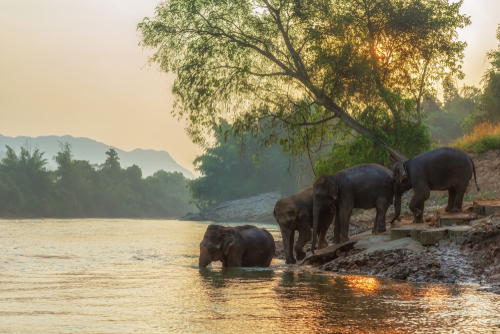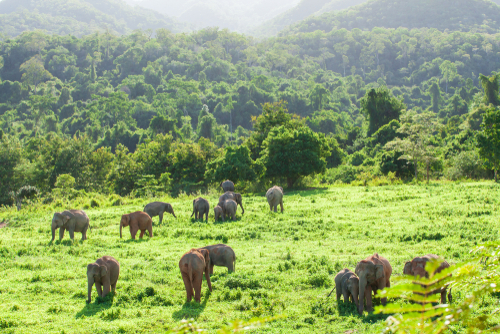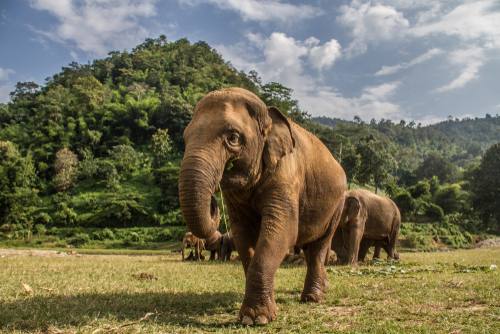Elephant Watching in Thailand
The elephant is the national animal of Thailand. It is severely endangered, after centuries of domestication and exploitation for heavy work. At the beginning of the 20th century, it was estimated that more than 100,000 elephants were in captivity in Thailand. Today, more than 3000 creatures still are, whereas less than 1000 elephants are left in the wild.

To go see elephants in the wild or in sanctuaries?
There are wild elephants in nature and then there are elephants that have been abused, used for work or entertainment and rescued in animal sanctuaries. Those are the two main possibilities for seeing elephants.
You can visit those in nature and see them from afar. You will enjoy observing the dynamics between them and amongst the herd.
In some sanctuaries, you can touch elephants, wash and feed them during close encounters.
The kind of experience you chose depends on your sensitivity. If you are OK with handling creatures whom you are able to get close to and touch because they have been once brutally submitted into domesticity, then go to a sanctuary. But make sure it is the right type of ethical sanctuary and that they are not perpetuating abuse, even in involuntary ways.
*See our article What Do Vegans Do if They Want to See Elephants for some guidelines.
What kind of elephants can I see in Thailand?
The Thai elephants are one of three types of Asian elephants. Asian elephants are always smaller than African elephants. The Elephas maximus-indicus of Thailand is the same subspecies as the Indian elephant, though the elephant from Thailand tends to be smaller, with shorter legs and a thicker body than the Indian one.
When is the best season to visit the elephants?
All year round but you may like the rainy season when the forest is most green and lush from June till October, though some places close for the wet season and people usually prefer travelling to Thailand in the winter, which is the dry season, when the heat is less strong and oppressive. The best time to watch elephants is late in the afternoon, one the heat gives off a bit.

What are the best places to see elephants in the wild?
Kui Buri
With only approximately 3000 elephants left in the wild in the whole of Thailand, seeing a large concentration of elephants at once is challenging. But if you want to observe the pachyderms in their natural habitat, your best chance to do it is in Kui Buri more than in any other national parc in the country as it boasts more than 300 elephants right there.
Four hours south of Bangkok, the elephant watching area is actually 20km away from the Kui Buri National Park and since Google maps seems to not cover the small details in this area, make sure to ask for directions once in the vicinity if you are driving. The park is only open for 4 hours in the afternoon, from 2pm-6pm. You’ll be transported in a utility vehicle equipped with wooden seats and guided by a ranger.
Kaeng Krachan National Park
Situated 3 hours south-west of Bangkok, this is one of the largest national parks in Thailand, with many animals to watch such as deers, gibbons, tigers and leopards, though these felines as well as the elephants can be pretty shy and there is no guarantee you will be able to spot some. This does not mean you will not be enchanted by the butterflies, the birds and the stunning nature. If you decide to camp in one of the assigned sights, plan in advance and bring your own food. The park is closed during the rainy season (June to end of October). Rent a 4-wheel drive when in Bangkok if you are planning to drive, since you may not have access to many sites in the park without it.
Which are considered the best ethical sanctuaries?
Elephant Valley, Chiang Rai
An hour and 15 minutes by plane north of Bangkok, close to the Laos border, this is probably one of the most ethical elephant sanctuaries in the world. They care for 6 elephant survivors, within 40 acres of paradisiacal land where the elephants are free to roam. You can observe them in their natural habitat and feed them at midday. The sanctuary also minds mentally ill elephants who became broken during particularly cruel domestication manoeuvres. You might want to stay half a day, but many people decide to stay longer. You can volunteer there for several months if you wish. They offer a homestay and lunches with Thai vegetarian options. They pick you up from your hotel in Chiang Rai for day visits. You can rent a car in Chiang Rai and drive the 3 hours to Chiang May to see the Elephant Nature Park here below.

Elephant Nature Park
This sanctuary is situated 10 hours north of Bangkok by car or one-hour flight to Chiang Mai, the closest town to the refuge. It hosts, treats, and generally takes loving care of 85 elephants recued from work, abuse or entertainment. The park enforces strict rules as to what is allowed or not. Riding the elephants for example is not. Though you are allowed to feed, wash or walk them. In fact, it is encouraged since the staff there appreciate the help of the visitors. Half a day visit is the most popular choice, though you may want to volunteer for a week or more, lead a spartan life and take care of the animals (the park is also a refuge for 400 cats and dogs). The cafeteria offers a vegetarian buffet, so you can expect to find some vegan options there.




